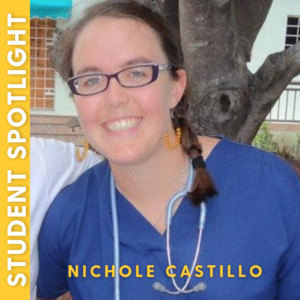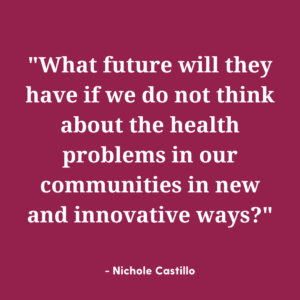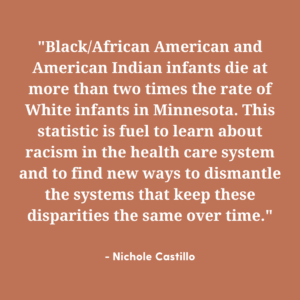#UMNMCH student Nichole Castillo; she/her/hers (MPH 2022) wrote this reflection on how her coursework, experience as a Pediatric Nurse Practitioner, and deployment with MDH have contributed to her career in MCH.
Background
After working for several years in primary care, I became interested in pursuing a Master’s in Public Health. When I first graduated as a Pediatric Nurse Practitioner, I lived in the Dominican Republic for a year through a program called the Gruber Fellowship for Global Justice and Women’s Rights. My role in the program was supporting the hospital’s emergency room and mobile clinics through the execution of direct pediatric acute and preventative care, as well as developing protocols for more efficient evidence-based care. In addition, I had involvement in public health programming areas such as clean water, family planning, and health promoter training. While there, I saw over and over that despite the health care system’s best efforts at health prevention, kids are profoundly impacted by their social environment. This is what led me to want to understand more about the drivers behind these kids experiencing such horrible inequities in their health to begin with and what we could do to change them. After leaving the Dominican Republic and while working in an urban Minnesota hospital, I saw babies being born and then discharged to homeless shelters or doubling up with family/friends and wondered how we could lead them towards a healthier future. What future will they have if we do not think about the health problems in our communities in new and innovative ways? I knew that I had stories to tell about persistent health disparities and wanted to gain the tools of epidemiology and statistics to be able to pair data with personal patient stories to effect change. My interest in infant mortality and health inequities led to a deployment with the Minnesota Department of Health, where I partnered with several different professionals from the Child and Family Health division over the last 16 months.
Minnesota Department of Health (MDH) Deployment Part I
I began a deployment as an intern with the Women and Infant Health subdivision at MDH during the fall semester of 2020. Beginning an internship in the middle of an uncertain part of the Sars-Cov-2 pandemic was a challenge as staff were being stretched far beyond their normal roles. The MDH professionals were still more than willing to teach me about the current efforts underway to promote safe sleep for infants in Minnesota in order to prevent deaths from SIDS/SUIDS. I also met with leaders from other states to learn about what they have done in terms of preventing infant deaths from SIDS/SUIDS in their respective locations. Cribs for Kids, a national organization, was a tremendous resource in the process of how Minnesota may recruit more hospitals to become safe sleep certified in the future. At the end of the Spring 2021 semester, I developed a safe sleep survey that was sent out to all birthing hospitals in Minnesota to gather baseline data about their current practices regarding safe sleep. This survey also helped identify hospitals who would be interested in becoming safe sleep certified in the future. The survey results were helpful at seeing where there are possible places for improvement and areas of strength in hospitals regarding infant safe sleep policies and practices.
Infant Health Disparities & MDH Deployment Part II
The more coursework I took in the MCH program, the stronger my interest became for learning what infant disparities exist in Minnesota and digging into the data more. The most troubling statistic is that the disparities in infant deaths have not largely changed in the last 20 years in Minnesota. Black/African American and American Indian infants die at more than two times the rate of White infants in Minnesota. This statistic is fuel to learn about racism in the health care system and to find new ways to dismantle the systems that keep these disparities the same over time. Since the Fall of 2021, the deployment with MDH has evolved to be more data-focused. I am working with a WIC Research Scientist to examine a large data pull of paired Birth/Death records for WIC participants in Minnesota in order to enumerate what the demographic differences may be in moms and babies who end up experiencing a postneonatal death (death of an infant from 29 days to 364 days of life) compared with the whole population of WIC participants from 2014-2019. This data analysis will also serve, when finished, as my culminating experience. The end goal of this work is to inform local public health and primary care providers about how to reduce infant death disparities in Minnesota.
Biography
Nichole is a part-time fifth-year MCH student. Nichole received her Bachelor’s in Nursing from the University of Wisconsin-Madison and her Master’s in Nursing as a Pediatric Nurse Practitioner from Yale University. She is currently working as a Pediatric Nurse Practitioner in primary care at Hennepin Healthcare in Minneapolis. In her free time, she enjoys hiking, skiing, biking, trying new restaurants, and chasing after her son.
REFERENCES
Child and Family Health Division. (2019, August 1). Infant Mortality: The death of an infant born alive under age 1. Minnesota Department of Health. https://www.health.state.mn.us/docs/communities/titlev/infantmortality.pdf
–Read Student Spotlight archives
Interested in learning more about getting a degree in MCH? Visit our MCH Program page for more information.
#UMNMCH #UMNproud #UMNdriven
[Tags] Student Spotlight…


